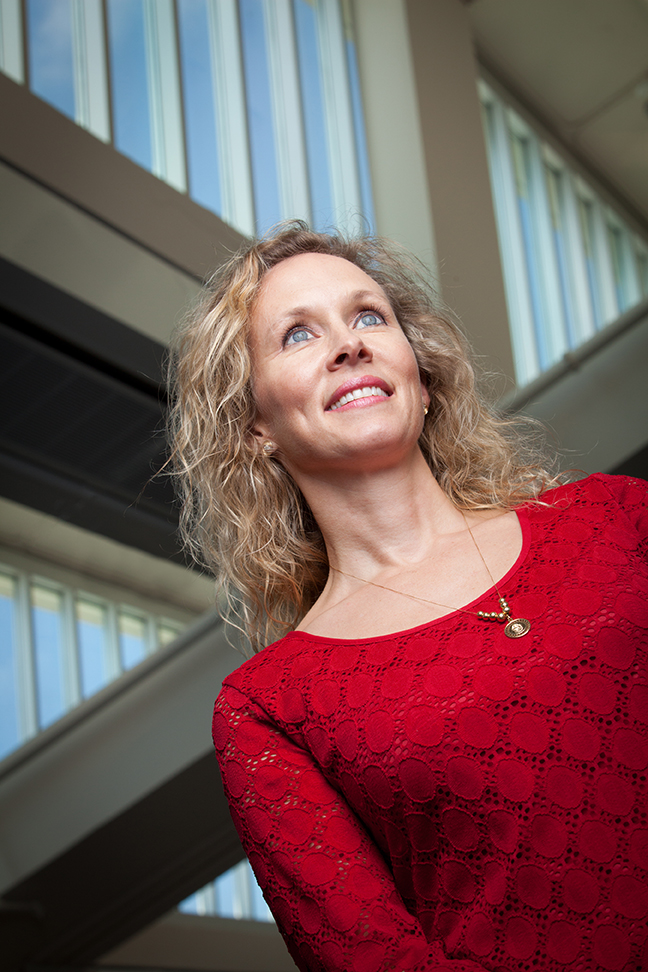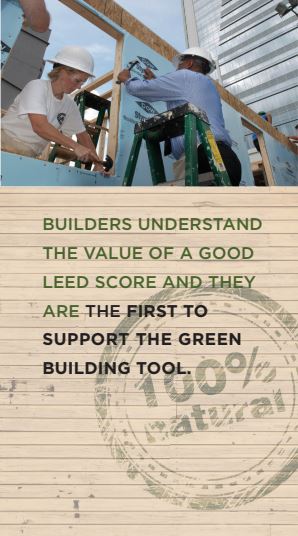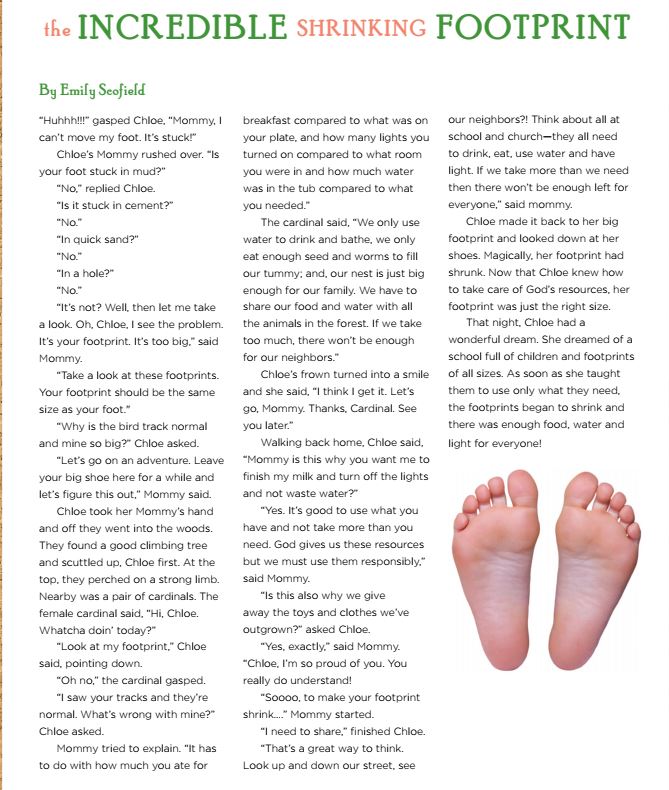The Incredible Shrinking Footprint of Environmentalist Emily Hanson Scofield

By: Cythnia Adams | Photos By: Nancy Evelyn
People may wrongly think that environmental science is all about the great outdoors, but Scofield explains it is also about the great indoors. “We spend 90 percent of our time indoors and (environmental science) becomes relevant to the population.”
Environmental science is a multidisciplinary academic field that integrates physical and biological sciences to the study of the environment and the solution of environmental problems. It provides an integrated, quantitative, and interdisciplinary approach to the study of environmental systems. Green building refers to a structure and use process that is environmentally responsible and resource-efficient throughout a building’s life-cycle: from siting to design, construction, operation, maintenance, renovation, and demolition.
Emily Hanson Scofield (MS ’99), the Executive Director of the U.S. Green Building Council’s North Carolina Chapter, is surrounded by people at the meet-and-greet event for the Piedmont Triad membership. Her blue eyes crinkle as she smiles and mingles with builders, vendors, and general members there to hear a regional presentation in Greensboro, N.C. Scofield wears a dark, pin-striped pantsuit with a strand of pearls, and her blonde curls are held back with a clip. Her vibe is sociable and warm, minus the corporate veneer. But she is USGBC’s executive director, and also a new inductee into UGA’s Forty Under Forty program. Since the award, media reports have cast her into the spotlight.
On a summer evening, Scofield waits patiently to address the group, but the time runs over and she does not seem annoyed. In the audience is Katie King, a Winston-Salem attorney. King works for a firm whose client base includes a large coal mine corporation. Like Scofield, she has always been interested in environmental issues. “But I’m practical,” King says. A quality she also shares with Scofield.
A Magazine Subscription and an Expanding World
When Scofield was 13 and growing up in Conyers, Ga., she purchased a magazine subscription to Greenpeace. Conyers was different then, she stresses, still a small town not yet part of metropolitan Atlanta. Her parents appreciated the environment and supported her learning. She identified herself as an environmental crusader from thereon, saying, “It’s the pebble in the lake effect.”
Scofield read and traveled abroad while young, all of which gave her a broader, global viewpoint. In 1990, at the age of 15, she became attuned to the Earth Day revival around the country.
“I listened…I heard that message,” she says. “It reinforced ideas of environmental awareness.”
Scofield revisits the matter of that magazine subscription. “People form an opinion when you mention ‘Greenpeace.’ It made an impression on me. It’s not my personality to be so extreme or divisive.” For a moment, she grows quiet. “But my eyes were opened to issues around the world.”
Now wife, mother, and educator with a large platform, Scofield’s world has widened still further. She pauses, her blue eyes filling. “I want to teach people to get outside their bubble. You have to think globally. Our world is not getting smaller, our world is global.”
While Scofield was in high school, her mother began graduate studies at UGA. “I used to go with her when she was studying media science. I would sit outside, or go to the library.”
Though she liked UGA, Scofield wound up attending Queens University in Charlotte, N.C., due to her involvement in college soccer and her famously independent streak. “I knew I wanted to go somewhere that I didn’t know anybody. I didn’t want to follow the crowd, and I was eager to expand my sphere of influence.”
At Queens, she studied biology, noticing that all but a minor percentage of her fellow biology majors were in pre-med.
Again, Scofield broke from the crowd—she remained true to her interest in environmental science. And she fully expected to continue her education in order to enter the field. A Queens’ professor bluntly asserted that “If you aren’t paid to be at grad school you are not good enough to go.” Scofield was both stunned and energized by the remark, and looked at both UNC-Chapel Hill and UGA. She identified a role model at UGA and soon made her decision to study environmental health there.
“I became interested in Dr. Mary Alice Smith. I was intrigued by her research and went to campus before being admitted to the program to make sure she knew who I was. Maintaining contact after this introduction, I let it be known that I wanted to come to school there and work with her. Fortunately, I was accepted and invited to be her research assistant. And, I got school paid for by that, but I had to work for it.”
Smith became Scofield’s advising professor in the Environmental Health Science program. “She really sharpened my scientific research and critical thinking skills. She introduced me to so many important aspects of conducting a valid, peer-reviewed contribution to science. She was an amazing example of how a career woman could lead with confidence, intelligence, and approachability.”
Scofield wanted to change the world, but from within. “Early on, I wanted to work on the regulatory side (like the EPA) and then parlay that knowledge to work with corporate America and help them comply.”

At South End, a Repurposed Charlotte Neighborhood Finds a Beginning
Two decades later, and few weeks after her meeting in the Piedmont Triad of N.C., Scofield is back on her home turf in Charlotte. She works from a home office, but her work carries her throughout the state which she is changing. It was always, after all, her big idea to be a part of change making.
She has shuttled her two young children to school and settles into a metal chair for a morning meeting outside Pike’s Old Fashioned Soda Shop in the South End industrial district of Charlotte. The choice of place was deliberate. She mentions Pike’s simplicity, which is reminiscent of its previous incarnation as a pharmacy with a sandwich and soda counter.
“It’s an old fashioned restaurant to boot, not ‘fusion fancy.’ Just an old soda shop…on the light rail line.
Then she adds, “Right next door is a construction company I worked for; when they renovated it they made it LEED silver.” LEED silver is one of several designations awarded for having met green building standards. The USGBC creates the LEED rating’s metric. (See Sidebar on LEED.)
Pike’s moved from its original location into a smart-looking refurbished building, part of a cluster that occupies several blocks in the shadow of Charlotte’s impressive skyscrapers and cityscape. It is a USGBC success, a model, in a star setting.
Scofield gestures. “You’re looking at what the U.S. Green Building Council does,” she explains. “It’s about using smart and efficient technologies. This used to be the Nebel Knitting Mill. It has been preserved and adapted.”
The mill’s buildings had long languished, empty and purposeless. Nebel Knitting Company was formerly a major force in the textiles industry—and one of the largest manufacturers of its kind in the Southeast. The company once employed hundreds of people in the red brick buildings that line Camden Road.
Nebel’s holdings were sold, but until the late 1980s various manufacturers had come and gone in the location near Dilworth, a popular and upscale neighborhood. Today, designers, service businesses and others have taken residence in the former textile plant’s site—at far remove from its days when hosiery was made here.
Across the street is South End’s light rail station. Charlotte has also placed trolley cars back into service, to the delight of many downtown revitalization boosters.
Scofi eld is youthfully outfitted in pink, with a multicolored nubby scarf wound around her neck. Again, her exuberant curls are clipped back from her face. She acknowledges many of the people who file past as she talks, colleagues from both present and past roles she has fi lled. Scofi eld has also taught environmental science classes in the Charlotte area. Keith Pehl, a former board USGBC member from Optima Engineering, stops by and engages her.
“I definitely feel like I get to make an impact; it’s an exciting space to be in,” she sighs happily.
“USGBC holds monthly lunch programs in the building one block over,” Scofield explains. “So I am in this part of town often.” She and her family live in the south Charlotte area called Ballantyne.
She points as a train approaches, noisily clattering. Soon a large group of equally noisy school children emerge from the station and pour into the street. From a dying part of town, South End has been rejuvenated. Today, it is a destination for shopping and dining, and its weekday morning vitality is robust. There are fewer parking spaces as morning segues into noon and umbrellas dotting the patio open to shield diners.
As the train overwhelms conversation, Scofield sips water and greets another passerby who calls a greeting to her.
This portion of the South End area is popularly called the Design Center, she explains. “It’s known for home décor and unique places,” Scofield says, adding, “There is a creative vibe.”
The U.S. Green Building Council is a nonprofit organization that also has taken a creative path to growth. While it is not a government organization, it has a national parent based in D.C., and more than 70 chapters across the country.“
The North Carolina program is held up as a model program, she says. “Our annual fundraising campaign is used as a model for the chapters across the country.” A recent USGBC fundraising gala in downtown Charlotte sold out early, and Scofield says this is a nice problem to have. She explains that they are sharing what they have learned in Charlotte with fellow chapters and creating a “playbook” of sorts.
“With the recession and continued struggles, especially in the construction industry, they (the national chapters) need a more structured program. Because we had this program in place before the recession, we have managed to increase the funds we have raised, so we are successful and financially stable at a time when other chapters are struggling.”
Scofield’s obviously proud as she adds, “When you’re in the forest it is not always easy to see the path in front of you. When I landed the job with USGBC NC, I was able to look back at my career path and say, ‘Those were all correct steps. The experiences gave me more arrows in my quiver, to be ready for the executive director role.’ I feel the job I have now is a perfect fit for my education and my passion. I am glad to be able to contribute and lead in this field.”
Now only age 38, Scofield first became involved with USGBC as a member and volunteer with the Charlotte Region Chapter when she was 32. She volunteered with the council’s educational programs committee while working as safety and environmental director for a construction company.
In 2010, she noticed a USGBC job posting while vacationing with her family in Hilton Head. The application was due that very day. Her husband gathered up their two children while she quickly prepared an application.
Scofield was hired as executive director of the Charlotte region chapter for USGBC. Only a year and a half later, came discussions of merging all the state’s chapters. At the end of 2012, the merger was complete and Scofield took on the expanded, statewide role.

Taking the LEED
Today, Charlotte has become a statewide model for innovations. The Queen City has won acclaim for its foresight in adapting light rail and also for its proactive stance on green building.
“Asheville, too, is doing amazing things on the residential side,” Scofield says. “Cary, Raleigh, and Durham, have a strong educational presence. Charlotte is leading the way with its commercial LEED certifications and Energy Star. The universities across the state are incorporating fields of study— not just architecture and construction management, but also with the engineering field, interior design, and business management. Even the financial field.”
Environmental science is where these interests intersect, Scofield says. “Some people say it’s not a new concept but it is becoming more mainstream. All of environmental science is completely interdisciplinary. You have to add in social sciences, hard sciences, policy makers—it’s a completely interdisciplinary field.” People may wrongly think that environmental science is all about the great outdoors, but Scofield explains it is also about the great indoors.
“We spend 90 percent of our time indoors, and (environmental science) becomes relevant to the population.”

Beyond Maslow’s Theory
Every social cause has its moment, Scofield realizes. And there are frequently overlapping issues that may have to do with our environment, she says. One such example is obesity. We are increasingly aware of obesity now, and dietary choices, but what we overlook is that there may be an environmental component as well.
An unhealthy workplace may actually be a contributing factor.
“If you are in a building that is not well built. with poor ventilation, trapping chemicals, you can tie that together to people not feeling well and not exercising—and then dealing with obesity,” says Scofield.
She describes an exercise in which she has people close their eyes and imagine a favorite vacation spot, or a favorite “safe spot.” The exercise makes her point for her.
“Overwhelmingly, when you ask people to tell you where it was, they were outdoors. There is this basic desire to commune with nature; the benefit we receive from sunlight, and fresh air, all of this is of wonderful benefit to our bodies. If we sit the majority of the time in these dark, dank environments with poor indoor air, there are consequences. Let’s do what we can with these structures to bring the outdoors in…so many wonderful benefits.”
She discusses Maslow’s hierarchy of needs and mentions a children’s story she wrote and titled, “The Incredible Shrinking Footprint.”
“I communicate to audiences young and old that every little bit you do, small, or large, makes a big impact. I try to focus on this…it’s what USGBC does. The chapters across the country educate, advocate and promote these products, practices, ideas…(teaching) what you can do.”
Her motivation, and modus operandi, is not the “shock jock” doctrine, Scofield says. But when she addresses an audience, she does question their chief motivation. “Is it money, is it your children. Is it your health. Let me meet you there. I don’t care what the motive; if it causes you to make this little improvement, we are getting there, and moving closer to the end goal.”
Children will help drive change, she feels. To that end, Scofield discusses USGBC’s Center for Green Schools.
“The Center created a ‘Green Apple Day of Service.’ You go and do a one-day blitz of raising sustainability awareness in our schools. There were green apple projects across the state and country— over 2,000 in all,” she says happily.
“I’m very happy with life right now,” Scofield smiles. “But the stories, and my whole vision for reaching children in today’s world, that is where I want to be…running a multimedia conglomerate.” She wants to carry the environmental message through children’s stories, cartoons, toys, books and school curriculum.
On October 3 and 4, Scofield performed her own Green Apple service. She took her original story, “The Incredible Shrinking Footprint” and read it to her three-year-old son’s class and her daughter’s kindergarten class. She will do it again whenever she can, whether it’s a service day or not.
She says she will continue to write, something she enjoys as much as she enjoys reading. And, with a glimpse of the young girl who was enlightened to try and save the whales, Scofield again smiles broadly. She will keep her blue eyes open wide.
So What’s the Big Idea?
“My big idea is for everyone to realize that they have a role in environmental protection, no matter what political party you are affiliated with, or your income status,” she says. The environment should not be politicized.
“Every day, everyone uses resources from the planet, and we cannot continue taking, taking, taking without being concerned about sharing. Giving back.”
Scofield frowns. “It’s such a simple concept. Who wants to argue, ‘No, I don’t care about clean air,’ or, I’d rather drink dirty water? These are basic human needs, and our actions impact the ability of our planet to meet these needs.”
She is quiet, and positive, but one thing makes her want to raise her voice. “Again, it stems from people thinking locally. The fact that we have such abundance, we are not forced to think about a shortage of anything. I would like to see us not get to the point of drastic need, drastic measures.”









